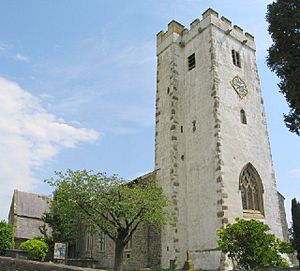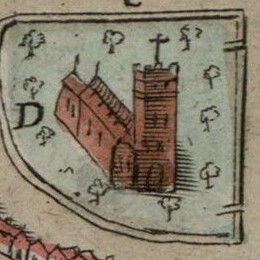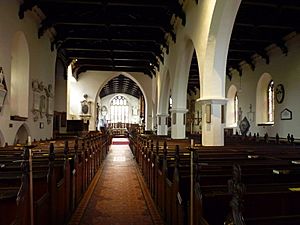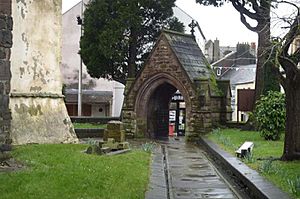St Peter's Church, Carmarthen facts for kids
Quick facts for kids St Peter's Church |
|
|---|---|
|
Eglwys San Pedr
|
|

St Peter's Church (2005)
|
|
| Location | Carmarthen |
| Country | Wales |
| Denomination | Church in Wales |
| Previous denomination | Roman Catholic |
St Peter's Church, known as Eglwys San Pedr in Welsh, is an important church in Carmarthen, Wales. It's part of the Church in Wales. Even though it started much earlier, the building you see today is from at least the 1300s. It's the biggest church in the Diocese of St David's area and is a special Grade I listed building, meaning it's very important historically. It's also the oldest building still standing in Carmarthen.
Contents
History of St Peter's Church
It's not fully known if an older church stood here before the Normans arrived. However, St Peter's is located within the old Roman town of Moridinum. It sits near where the Roman walls' west gate might have been.
The church was likely built after the Norman castle. It was placed between the castle and an older religious settlement called Llandeulyddog. This spot helped it serve both the Welsh people in Old Carmarthen and the new town that grew around the castle.
Building Through the Centuries
St Peter's Church was given to Battle Abbey between 1107 and 1124. The church building we see today probably started later. The main parts, like the nave (the central area) and chancel (the area around the altar), are from the 1200s or 1300s.
The south aisle (a side section) and north transept (a cross-shaped part) might be from the late 1300s. The tower was rebuilt about 100 years later, and a porch was added then too. In the 1500s, the nave and chancel were made taller and mostly rebuilt.
Changes Over Time
During the 1500s, when monasteries were closed down by the Tudor kings, St Peter's became owned by the Crown. Important church court meetings were held here. For example, Bishop Robert Ferrar was tried at the church in 1555.
Later, in 1816, the church came under the care of St David's College, Lampeter. In the early 1900s, it then became part of the Bishop of St Davids's area.
One famous person buried at St Peter's is Sir Richard Steele. He was a writer from the 1700s. He married a local woman, Mary Scurlock, and passed away in Carmarthen in 1729.
Until the 1800s, St Peter's was the only Anglican church in Carmarthen. This changed when St David's Church opened in the late 1830s. St Peter's had repairs and updates throughout the 1800s. The current clock on the tower was added in 1903 or 1904.
In 1954, the church was given a Grade I heritage listing. This means it's a very important historical building.
What St Peter's Church Looks Like
St Peter's is said to be the largest church in Wales. It also has the longest nave in its diocese. The church walls are made of stone, and the roofs are slate. The tall tower at the west end is a well-known landmark. It has a square staircase on one corner. The tower was painted white in 2001.
Inside the tower are eight bells. Four of these are the original bells, made in 1722. The south porch was changed into a war memorial chapel in 1969. Its door was replaced with a pointed window. The main way to enter the church is through the door at the bottom of the tower.
The main part of the church has a long nave and chancel. These are separated from the south aisle by five arched sections. The inside of the church is about 52 meters (170 feet) long. This is from the west tower door to the east window. The nave and south aisle together are about 15 meters (50 feet) wide.
The special wooden roofs were replaced in 1785 by John Nash, who also worked on Buckingham Palace. However, these roofs were replaced again in 1861 during other repairs. Many windows were replaced in 1846 or changed in the 1860s. The pretty floor tiles in the chancel and aisles were added between 1866 and 1876.
The church has many important tombs and memorials inside. One tomb belongs to Rhys ap Thomas. He is thought to have delivered the final blow to King Richard III.
The northwest entrance to the churchyard has a red stone lychgate and iron gates. A lychgate is a roofed gateway to a churchyard. This one was designed in 1879 to remember Reverend Latimer M. Jones. He was the vicar of the church from 1863 to 1877. This gate is also a listed building.
Challenges for the Church
In 2014, the vicar, Reverend Leigh Richardson, shared that the church had very little money left. With running costs of £50,000 each year, the church was at risk of closing. They had recently spent £20,000 to fix a main stained glass window that was damaged.
One idea to get more visitors and money was to have a display about the Black Book of Carmarthen. This is a very old and important Welsh manuscript. In 2015, a concert was held to raise money. The money went to the church and to charities supported by the Welsh Guards.
Legend of St Peter's
In his book Historia Regum Britanniae, Geoffrey of Monmouth wrote about the legend of Merlin. He said that Merlin's mother used to live with nuns in the church of St Peter in Carmarthen.




